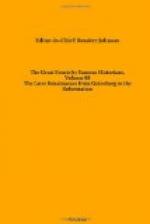4. That John Cabot, accompanied perhaps by his son Sebastian, sailed from Bristol early in May, 1497. He discovered and landed upon some part of America between Cape Cod, in Massachusetts, and Cape Chidley, in Labrador; that he returned to Bristol before the end of July of the same year; that, whatever might have been the number of vessels which started, the discovery was made by John Cabot’s own vessel, the Matthew of Bristol, with a crew of eighteen men.
5. That thereupon, and in consideration of this discovery made by John Cabot, King Henry VII granted new letters-patent, drawn solely to John Cabot, authorizing a second expedition on a more extended scale and with fuller royal authority, which letters-patent were dated February 3, 1498; that this expedition sailed in the spring of 1498, and had not returned in October. It consisted of several ships and about three hundred men. That John and Sebastian Cabot sailed on this voyage. When it returned is not known. From the time of sailing of this expedition John Cabot vanishes into the unknowable, and from thenceforth Sebastian alone appears in the historic record.
These points are now fully supported by satisfactory evidence, mostly documentary and contemporary. As for John Cabot, Sebastian said he died, which is one of the few undisputed facts in the discussion; but if Sebastian is correctly reported in Ramusio to have said that he died at the time when the news of Columbus’ discoveries reached England, then Sebastian Cabot told an untruth, because the letters-patent of 1498 were addressed to John Cabot alone. The son had a gift of reticence concerning others, including his father and brothers, which in these latter days has been the cause of much wearisome research to scholars. To avoid further discussion of the preceding points is, however, a great gain.
From among the numerous opinions concerning the landfall of John Cabot three theories emerge which may be seriously entertained, all three being supported by evidence of much weight: 1. That it was in Newfoundland. 2. That it was on the Labrador coast. 3. That it was on the island of Cape Breton.
Until a comparatively recent period it was universally held by English writers that Newfoundland was the part of North America first seen by Cabot. The name “Newfoundland” lends itself to this view; for in the letters-patent of 1498 the expression “Londe and iles of late founde,” and the wording of the award recorded in the King’s privy-purse accounts, August 10, 1497, “To hym that founde the new ile LI0,” seem naturally to suggest the island of Newfoundland of our day; and this impression is strengthened by reading the old authors, who spell it, as Richard Whitbourne in 1588, “New-found-land,” in three words with connecting hyphens, and often with the definite article, “The Newe-found-land.” A cursory reading of the whole literature of American discovery before 1831 would suggest that idea, and




